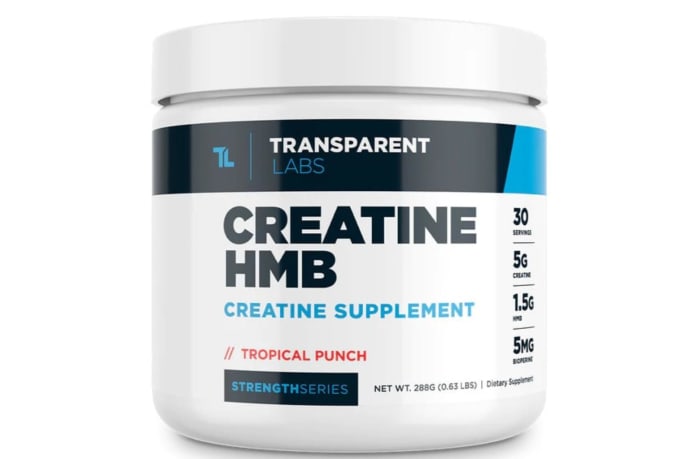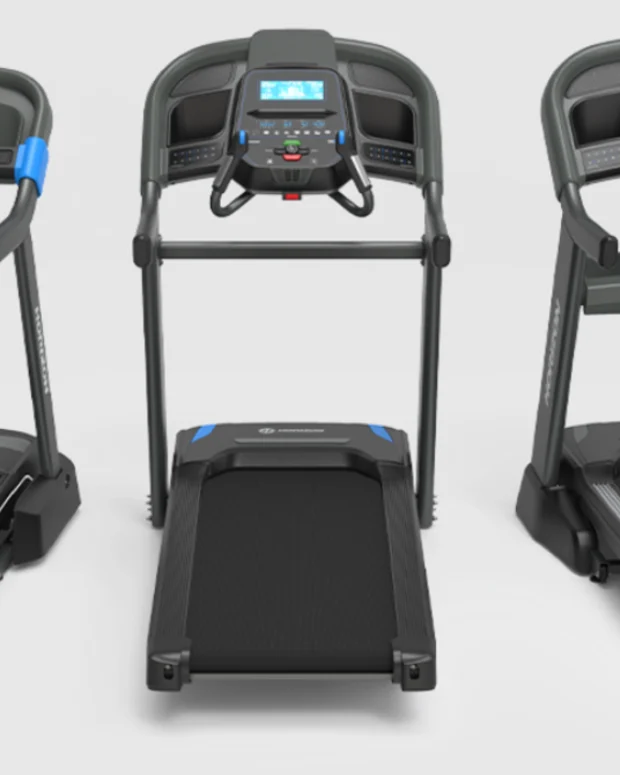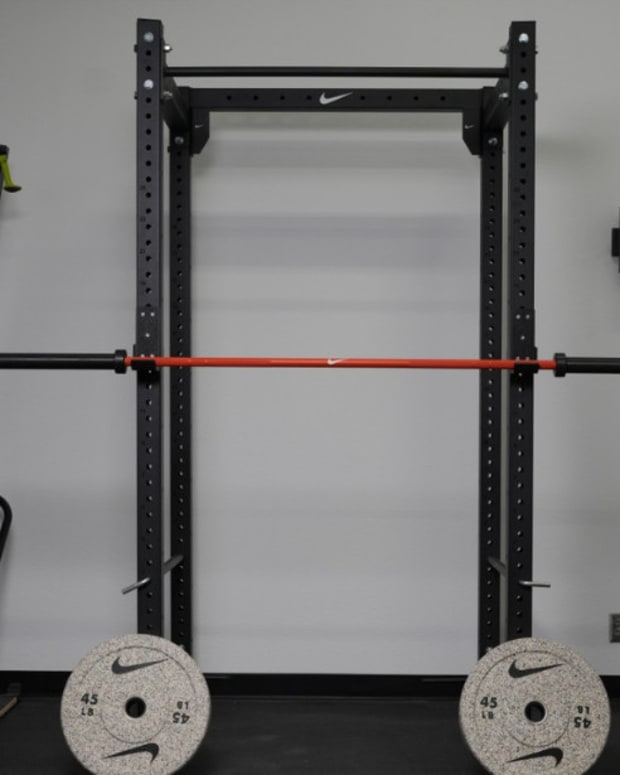The products featured in this article have been independently reviewed. When you buy something through the retail links on this page, we may earn commission at no cost to you, the reader. Sports Illustrated editorial staff are not involved in the creation of this content. Learn more here.
Creatine is commonly used as a muscle growth supplement because it helps increase strength, power and muscle mass and improve body composition. It's found naturally in meat, seafood and milk and is made by the human body in the kidneys, liver and pancreas. After converting into phosphocreatine (more on this later), it’s stored in the muscles and used for energy.
Creatine stores are maintained by ingesting three to five grams per day. According to the University of Delaware, pork, tuna, cod, salmon and beef contain between 1.4 to 2.3 grams of creatine per pound. While it’s not impossible to consume the daily recommended amount of creatine by eating these foods, this can lead to gaining body weight. Mass gainers also often contain creatine, but aren’t great for those who don’t want to consume a surplus of protein and carbohydrates. The best creatine supplements provide an inexpensive and efficient way to increase creatine intake without the excessive intake of calories.
In this article, we detail the potential benefits of creatine, how it works, several different types and supplement forms, possible side effects, how to take creatine and more so you can make an informed decision on whether this supplement is right for you.
What Is Creatine?
According to the National Institute of Health (NIH), creatine is a nitrogen-containing compound synthesized in the body from the amino acids glycine, arginine and methionine. It works to provide a source of energy for the adenosine triphosphate (ATP) molecule, which is the required fuel for muscle contraction. Creatine is produced naturally by the liver, kidneys and pancreas and is also found in meats, seafood and milk.
Monohydrate, micronized and alkaline
Creatine monohydrate is a soluble, stable form of creatine. The International Society of Sports Nutrition (ISSN) declares that creatine monohydrate benefits those who want to build skeletal muscle and improve exercise performance, and it describes creatine as, “the most effective ergogenic nutritional supplement currently available to athletes in terms of increasing high-intensity exercise capacity and lean body mass during training.” The ISSN deems creatine safe for consumption and notes that there is no scientific evidence that supports creatine monohydrate having detrimental effects on healthy individuals. This type of creatine is available as a pill, capsule or powder.
Micronized creatine has a smaller particle size to improve absorption and solubility. The micronization process makes each particle about 20 times smaller and is available in powder form.
The alkaline form of creatine, also referred to as “buffered” creatine, is designed to have a higher pH level than creatine monohydrate to increase stability and absorption. This type of creatine is offered in capsule or powder form and is usually more expensive than other types. The increase in cost could be due to claims of efficacy. One study shows that alkaline creatine can cause a creatine molecule to be more stable and be optimized better than other forms. However, another study compared the alkaline form to creatine monohydrate and found that the alkaline form promotes similar changes in muscle strength, anaerobic capacity and body composition, and does not result in fewer side effects. More research is needed to fully understand the effects and to determine if it’s worth the extra cost.
Creatine HCl vs monohydrate
Creatine monohydrate is creatine combined with a water molecule to improve strength, power and body composition and increase muscle mass. It is moderately soluble in water, but may not completely dissolve without shaking or stirring and may form clumps when mixed.
Creatine HCl is creatine combined with hydrochloric acid to create a salt form to improve solubility and absorption rates, which may produce better results. One study states these particles are 38 times more soluble than creatine monohydrate.
So, which should you choose? In one study, 36 participants were divided into groups and evaluated after taking creatine monohydrate, creatine HCl or a placebo for seven days. No significant differences in exercise performance were found between the groups who took the supplement, which means they are both equally effective.
More research is needed on the claim that creatine HCl can reach the cells more quickly and that it has fewer adverse effects than creatine monohydrate. No matter which you choose, consistently taking the recommended amount of approximately 20 grams per day in five-gram increments for at least three days followed by three to five grams per day will help maintain creatine stores in your muscles.
How Does Creatine Work?
Our muscles require energy to work during exercises like resistance training and bodybuilding. Once creatine is absorbed or made, it’s transported into the skeletal muscles. Then, two-thirds is phosphorylated to form phosphocreatine (PCr) to provide an energy source to the muscles.
This energy enhances the production of ATP so it can be synthesized into ADP (adenosine diphosphate) and then back to ATP. This conversion process, supported by creatine, increases high-intensity exercise capacity and lean muscle mass.
Benefits of Creatine
Creatine health benefits
During high-intensity exercise, the demand rate for ATP can increase up to 1,000 times when compared to the demand at rest. Creatine helps produce ATP using a process called PCr resynthesis, which occurs quickly and does not require oxygen. This is essential during high-intensity exercise when the body’s oxygen supply is limited because it increases athletic performance under fatigue. The Journal of the International Society of Sports Medicine (JISSN) states that creatine supplementation can also help build muscle mass when paired with a strength training routine.
Short-term creatine supplementation has been reported to boost athletic performance by increasing the maximal power and strength output during sets of muscle contractions. Creatine can also increase work performed during repetitive sprint performance by five to 15 percent, and single-effort sprint performance by one to five percent. The ISSN states, “Creatine supplementation can serve as an effective nutritional ergogenic aid that may benefit athletes involved in numerous sports as well as individuals involved in exercise training.”
There is evidence that creatine can reduce inflammation in athletes, those with elevated levels of inflammation due to disease and older adults prone to muscle and bone loss. That said, more research is needed to understand the level of effectiveness and dosage.
Related Post: The Benefits of Creatine for Women
Creatine cognitive benefits
All biological and cellular functions of the brain require energy from the molecule ATP. During heightened brain activity, phosphocreatine supplies decrease rapidly to maintain ATP levels. Research suggests that creatine supplementation can support and improve brain health and cognitive function. In a study involving mice, the group that had a depleted supply of creatine resulted in slower learning involving the spatial task.
Females specifically have been reported to have lower levels of creatine in the frontal lobe, and increasing creatine concentrations may support the reduction of depression symptoms and the effects of a traumatic brain injury. In a study involving mice and rats with traumatic brain injury, chronic administration of creatine improved the extent of cortical damage by as much as 36 percent in mice and 50 percent in rats. More research and studies involving humans are needed to evaluate the cognitive benefits of creatine on humans.
Related Post: The Best Creatine Supplements for Those Who Are Bulking, Cutting and More
Side Effects of Creatine
Creatine is a relatively safe dietary supplement, and the ISSN found no scientific evidence that supports it causing harm during long-term and short-term use in otherwise healthy individuals. A 2021 publication details the side effects of creatine supplementation such as water retention, hair loss, weight gain, kidney disease and more. This publication found that creatine supplementation does not:
- Always lead to water retention
- Result in kidney damage or have adverse effects on kidney function when healthy individuals take the recommended dose
- Cause hair loss (according to the majority of available evidence)
- Cause dehydration and muscle cramping
- Increase fat mass
Many of the reported side effects of creatine supplementation are associated with taking high doses and prolonged use, and further studies are needed. The Cleveland Clinic notes that your muscles may retain water in the early stages of taking the supplement, and it may be dangerous to take while dehydrated. Always consult your primary care provider before starting a dietary supplement.
How to Take Creatine
Different forms - pills, capsules, powders and gummies
Creatine supplements are offered as powders, pills or capsules and gummies, and brands like Transparent Labs offer vegetarian and vegan options. The supplement form does not make a difference in absorption, so the right choice for you comes down to personal preference and budget. Pills and capsules are a convenient option if you are on the go and want to skip mixing the powder with water. Creatine gummies are an excellent choice for those who want to avoid mixing a drink but don’t like swallowing pills. Creatine powders mix easily with a protein powder post-workout, and there are unflavored and flavored options.
Creatine loading phase
The creatine loading phase involves taking a high dose of creatine for five to seven days and then taking a lower dose for the following weeks. A high dose can be anywhere from 20 to 25 grams per day and is relative to body mass. Since consuming more than 10 grams can lead to gastrointestinal distress, high doses should be taken in smaller increments every four hours. The goal of creatine loading is to increase the amount stored in the muscle cells.
Research has shown that creatine loading increases muscle creatine stores by 10 to 40 percent. Other studies found that muscle strength and size increase when utilizing creatine supplementation with no loading period.
Creatine loading can benefit those hoping to maximize their muscle gain from weightlifting over a short period. However, those who plan on taking the supplement for more than 30 days should avoid loading because taking it in excess can lead to weight gain.
Our Favorite Creatine Supplements
Transparent Labs Creatine HMB
Transparent Labs Creatine HMB has 5,000 milligrams of creatine per serving. There are also 1,500 milligrams of HMB (beta-hydroxy-beta-methyl-butyrate) per serving and studies have shown that HMB supplementation can strengthen muscle, decrease fat while increasing lean muscle mass, and improve performance output. There are 10 flavors to choose from and an unflavored option. Transparent Labs did not include any artificial colors, sweeteners or preservatives and there’s the option to subscribe and save 10 percent.
XWERKS Lift Creatine
XWERKS Lift Creatine is micronized creatine monohydrate that has a smaller particle size to improve absorption and solubility and it improves strength, power and body composition and can help increase muscle mass. This is an unflavored powder that can be mixed with water or other supplements such as protein powder. It is gluten and dairy free and contains just one ingredient: creatine monohydrate.
Creatine Benefits FAQs
How much creatine should I take?
The ISSN recommends that healthy adults consume three to five grams of creatine per day and up to ten grams per day during a loading phase.
Does creatine make you gain weight?
No, studies have shown that creatine does not increase fat mass across a variety of populations. However, one possible side effect is water retention which may increase your body weight on the scale.
When should you take creatine?
The National Institute of Health (NIH) states that creatine can be taken any time of day, but the ISSN suggests that some athletes may benefit from taking it before or after exercise such as aerobic or strength training.
Related Post: When is The Best Time to Take Creatine?
Is creatine a steroid?
No, creatine has a completely different chemical composition and is not considered an anabolic steroid.
How long does it take creatine to work?
This depends on the individual dosage and form of creatine, but the NIH states that it can take several days or up to a week for your muscle creatine levels to increase when taking the recommended dosage consistently.
Prices are accurate and items in stock as of publish time.












